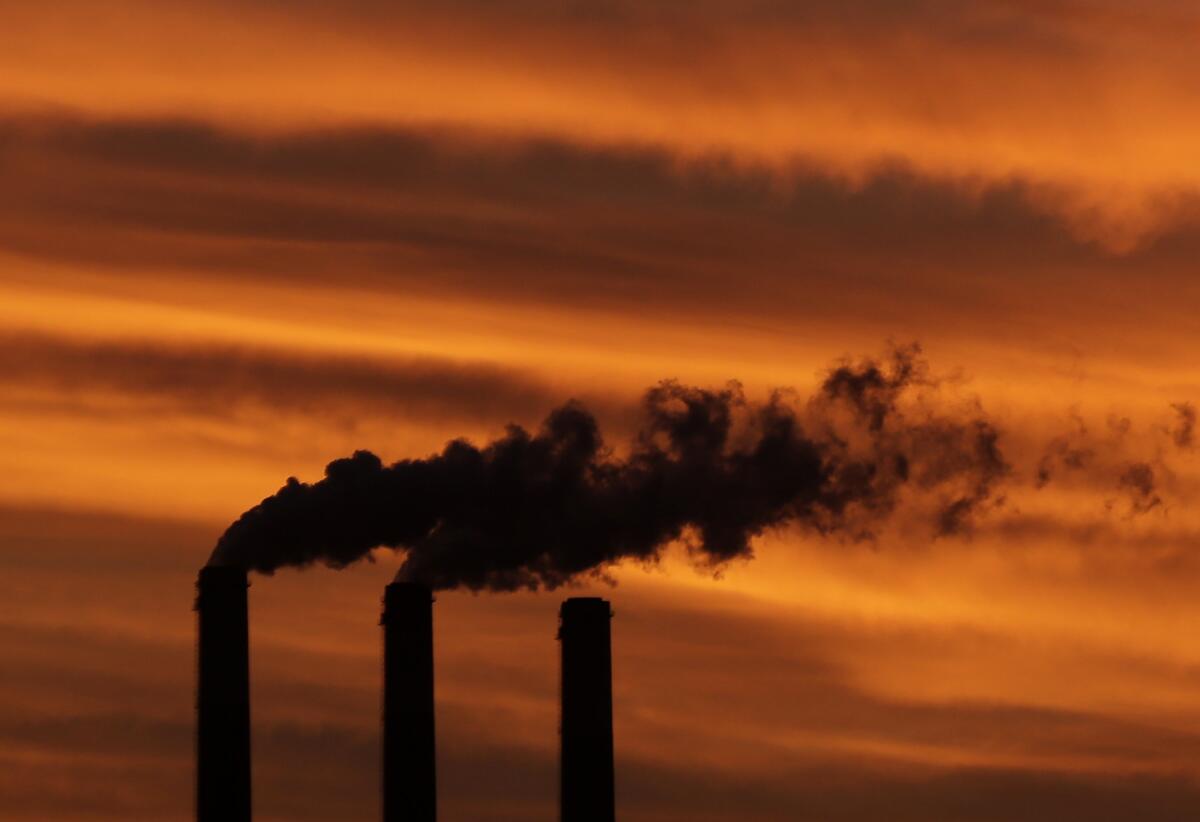Warning of ‘global catastrophe,’ U.N. says climate change measures are ‘highly inadequate’

- Share via
The world, especially richer carbon-emitting nations, remains “far behind” and is not doing nearly enough — nor even promising to do enough — to reach any of the global goals limiting future warming, a United Nations report said.
That “highly inadequate” inaction means that the window is closing, but is not quite shut yet, on efforts to keep future warming to just a few more tenths of a degree from now, according to Thursday’s Emissions Gap report from the United Nations Environment Program.
“Global and national climate commitments are falling pitifully short,” United Nations Secretary-General Antonio Guterres said Thursday. “We are headed for a global catastrophe.”
The world is weaning itself from fossil fuels too slowly, the report and experts said.
“The report confirms the utterly glacial pace of climate action, despite the looming precipice of climate tipping points we’re approaching,” said climate scientist Bill Hare, head of Climate Analytics, which examines what countries are promising and doing about carbon emissions.
Instead of limiting warming to 1.5 or 2 degrees Celsius (2.7 degrees or 3.6 degrees Fahrenheit, respectively) above pre-industrial levels, the global goals set by the 2015 Paris agreement, the way the world is acting now means that warming will hit 2.8 degrees Celsius (5 degrees Fahrenheit) by the year 2100, the U.N. report said.
Global heating is having dire effects on people and nature, the U.N. says, with urgent action needed to curb emissions and adapt to worsening effects.
Countries’ concrete pledges would bring that down to 2.6 degrees Celsius (4.7 degrees Fahrenheit). The world has already warmed 1.1 degrees Celsius (2 degrees Fahrenheit) since pre-industrial times.
“In all likelihood we will pass” 1.5 degrees Celsius, UNEP Executive Director Inger Andersen told the Associated Press. “We can still do it, but that means 45% emissions reductions” by 2030.
World Meteorological Organization Secretary-General Petteri Taalas said the U.N. weather agency has calculated a 50% chance that the world will likely hit the 1.5-degree Celsius mark temporarily in the next five years, and “in the next decade we’d be there on a more permanent basis.”
“We’re sliding from climate crisis to climate disaster,” Andersen said in a Thursday news conference.
UCLA cardiologist Barbara Natterson-Horowitz discusses the disproportionate effects of climate change on female animals, including women and girls.
The emissions gap is the difference between the amount of carbon pollution being spewed between now and 2030 and the lower levels needed to keep warming to 1.5 or 2 degrees Celsius.
Guterres said “the emissions gap is a byproduct of a commitments gap. A promises gap. An action gap.”
“We’re failing by winning too slowly,” said Stanford climate scientist Rob Jackson, who chairs the independent Global Carbon Project, which tracks carbon dioxide emissions around the world but wasn’t part of the U.N. report. “Renewables are booming and cheaper than ever. But COVID stimulus plans and the war in Ukraine have disrupted global energy markets and led some countries [to] revert to coal and other fuels. This can’t continue in a safe climate.”
In 10 days, yearly international climate negotiations under U.N. auspices will begin in Sharm El Sheikh, Egypt. In the run-up to the conference, several reports highlight different aspects of the world’s battle to curb climate change. On Wednesday, a different U.N. agency looked at countries’ official emission-reduction targets. Thursday’s Emissions Gap report looks at what countries are actually doing as well as what they promise to do in the future in various pledges.
Toward a more sustainable California
Get Boiling Point, our newsletter exploring climate change, energy and the environment, and become part of the conversation — and the solution.
You may occasionally receive promotional content from the Los Angeles Times.
The Group of 20 nations, the world’s richest countries, are responsible for 75% of heat-trapping pollution, Andersen said.
The U.N. report said that “G-20 members are far behind in delivering” on their promises to reduce emissions. Taking out the special cases of Turkey and Russia, current polices by G-20 nations fall 2.6 billion metric tons a year short of the 2030 goal, the report said. Both Turkey and Russia’s targets for 2030 have higher pollution levels than current policies project, and using their projections would make the G-20 emissions gap artificially low, the report said.
“It’s critical that China, as well as the U.S. and other G-20 countries, actually lead,” Andersen said. She hailed the newly passed $375-billion U.S. climate- and inflation-fighting law as an example of action instead of just promises.
The report said that by 2030 the U.S. law should prevent 1-billion metric tons of carbon emissions, which is much more than other nations’ efforts this year.
The sale of thousands of California gas and oil wells is raising concern about oversight of idle and orphaned wells.
“What we’re calling for is an accelerated pace because there are good things happening out there in a number of countries, but it’s just not fast enough and it’s not consistent enough,” Andersen said.
Overall, to get to the emission cuts needed, the world needs to transform to a low-carbon economy, which would require global investments of $4 trillion to $6 trillion a year, the report said.
More to Read
Sign up for Essential California
The most important California stories and recommendations in your inbox every morning.
You may occasionally receive promotional content from the Los Angeles Times.












